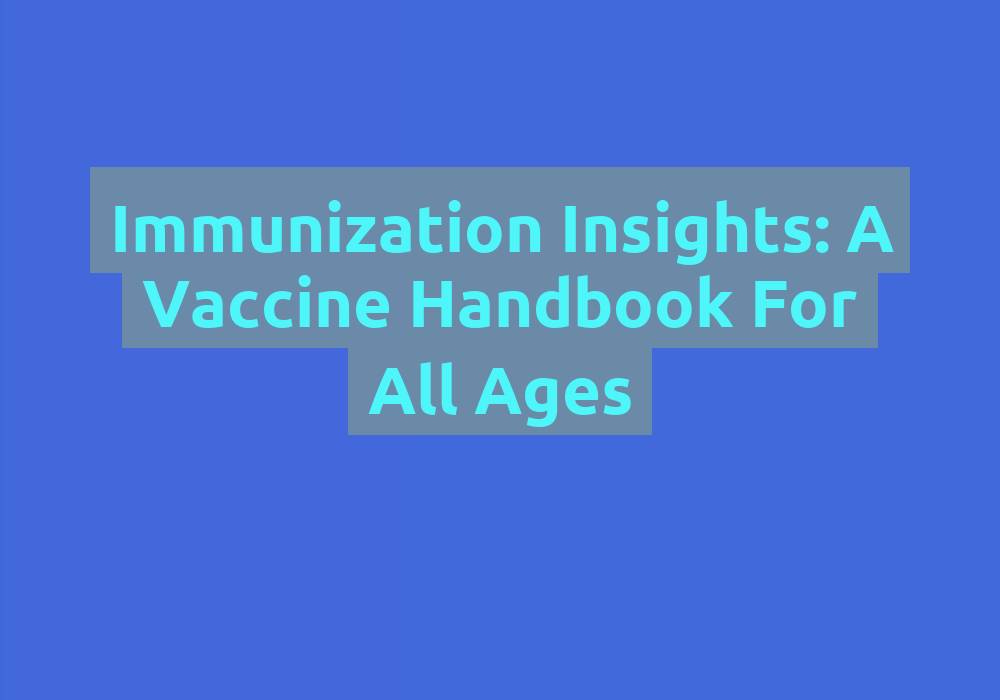Why the Pneumococcal Vaccine is a Must-Have for At-Risk Groups

Pneumococcal disease is a serious infection caused by the Streptococcus pneumoniae bacteria. It can lead to various illnesses, ranging from mild respiratory infections to severe conditions such as pneumonia, meningitis, and bloodstream infections. At-risk groups, including infants, older adults, and individuals with certain medical conditions, are particularly vulnerable to the harmful effects of pneumococcal disease. As a result, it is essential for these individuals to receive the pneumococcal vaccine as a preventive measure. In this article, we will delve into the importance of the pneumococcal vaccine and its benefits for at-risk groups.
Understanding Pneumococcal Disease
Pneumococcal disease is caused by the Streptococcus pneumoniae bacteria, which can be found in the nose and throat of healthy individuals. It is usually spread from person to person through respiratory droplets when an infected individual coughs or sneezes. This bacterium has more than 90 different serotypes, with varying levels of virulence and potential to cause disease.
Pneumococcal infections can manifest in various ways, depending on the type and severity of the infection. Common symptoms of pneumococcal disease include high fever, cough, shortness of breath, chest pain, fatigue, headache, confusion, and in cases of meningitis, a stiff neck. It is important to recognize these symptoms and seek prompt medical attention if they occur.
Common Symptoms of Pneumococcal Infections
-
High fever: Pneumococcal infections often cause a sudden and high fever, which is a sign that the body is fighting off the infection. Monitoring body temperature and seeking medical attention if it rises above normal levels is crucial.
-
Cough: A persistent cough is a common symptom of pneumococcal respiratory infections. It may be accompanied by phlegm or mucus and can be a sign of pneumonia or bronchitis.
-
Shortness of breath: Pneumococcal infections can affect the lungs and lead to difficulty breathing. Shortness of breath should not be ignored, as it may indicate a severe respiratory infection.
-
Chest pain: Chest pain can occur due to inflammation or infection of the lungs or pleura (the lining around the lungs). It is important to seek medical attention if chest pain is present, as it can be a symptom of a serious pneumococcal infection.
-
Fatigue: Pneumococcal infections can cause fatigue and weakness. Feeling excessively tired despite getting enough rest could be a sign of an underlying infection.
-
Headache: Headaches can occur as a result of inflammation and infection in the sinuses or meninges (the membranes surrounding the brain and spinal cord). If a headache is severe or persistent, it is essential to consult a healthcare professional.
-
Confusion: Pneumococcal meningitis, a severe form of the disease, can cause confusion and altered mental status. These symptoms should be taken seriously and require immediate medical attention.
-
Stiff neck (in cases of meningitis): Meningitis is characterized by a stiff neck, along with other symptoms such as headache, fever, and sensitivity to light. If a stiff neck is accompanied by other signs of infection, it is crucial to seek medical help promptly.
Who Are Considered At-Risk Groups?
Certain groups of individuals are more susceptible to pneumococcal infections due to their age or underlying medical conditions. These at-risk groups include infants, older adults, and individuals with chronic health conditions.
Infants and Young Children
Infants and young children have immature immune systems, making them more prone to pneumococcal infections. They are at higher risk of developing severe conditions such as pneumonia and meningitis. Vaccinating infants and young children against pneumococcal disease is essential to protect them from potentially life-threatening infections.
Older Adults
As individuals age, their immune system function declines, making them more susceptible to infections. Older adults are at increased risk of developing severe pneumococcal infections, particularly pneumonia. Vaccination against pneumococcal disease is highly recommended for the elderly to reduce the likelihood of illness and complications.
Individuals with Chronic Health Conditions
People with certain underlying medical conditions, such as chronic heart, lung, or liver diseases, diabetes, HIV/AIDS, and immunocompromising conditions, have weakened immune systems. Consequently, they are more vulnerable to severe pneumococcal infections. Vaccination is crucial for these individuals, as it can help prevent complications and potentially life-threatening consequences.
It is important for healthcare providers to identify individuals in these at-risk groups and prioritize pneumococcal vaccination to protect their health.
The Importance of Pneumococcal Vaccination
Vaccination is a vital tool in preventing pneumococcal disease and its associated complications. The pneumococcal vaccine helps stimulate the immune system to produce antibodies that provide protection against the bacteria responsible for causing the infection.
Benefits of the Pneumococcal Vaccine for At-Risk Groups
-
Prevention of Pneumococcal Infections: The pneumococcal vaccine significantly reduces the risk of developing pneumococcal infections, including pneumonia, meningitis, and bloodstream infections, in at-risk individuals. By stimulating the immune system to recognize and fight the bacteria, the vaccine helps prevent the initial infection.
-
Protection Against Antibiotic-Resistant Strains: Pneumococcal bacteria have become increasingly resistant to antibiotics over time. The vaccine can offer protection against antibiotic-resistant strains, reducing the chances of severe infections and limited treatment options. By preventing infections caused by drug-resistant bacteria, the vaccine helps preserve the effectiveness of antibiotics for other conditions.
-
Reduction of Illness and Complications: By preventing pneumococcal infections, the vaccine helps decrease the overall burden of illness and associated complications, particularly in vulnerable populations such as infants, older adults, and individuals with chronic health conditions. It can prevent the progression of mild respiratory infections to more severe conditions, such as pneumonia or meningitis.
-
Prevention of Hospitalizations and Mortality: Pneumococcal disease can lead to severe illness requiring hospitalization and, in some cases, even death. Vaccination significantly lowers the risk of hospitalization and mortality, particularly among at-risk groups. By reducing the incidence and severity of pneumococcal infections, the vaccine helps protect individuals from life-threatening complications.
Types of Pneumococcal Vaccines
There are two main types of pneumococcal vaccines available:
-
Pneumococcal Conjugate Vaccine (PCV13): This vaccine is recommended for infants and young children, as well as adults over the age of 65 and individuals with certain medical conditions. It provides protection against 13 serotypes of the pneumococcal bacteria. PCV13 is administered in a series of doses, with specific intervals between doses depending on age and health status.
-
Pneumococcal Polysaccharide Vaccine (PPSV23): This vaccine is recommended for adults over the age of 65 and individuals with certain medical conditions. It provides protection against 23 serotypes of the pneumococcal bacteria. PPSV23 is administered as a single dose, with potential booster doses for specific high-risk groups.
The choice of vaccine and the appropriate schedule for administration depend on the individual’s age, health status, and previous vaccination history. Healthcare professionals can provide guidance and recommendations based on the specific needs of each individual.
Vaccine Administration and Scheduling
The pneumococcal vaccine is administered through injection, usually in the upper arm. The number of doses and schedule may vary depending on the age, health status, and previous vaccination history of the individual.
For infants and young children receiving PCV13, the vaccine is typically administered in a series of doses starting at 2 months of age, with additional doses given at specific intervals. The exact schedule should be discussed with a healthcare professional.
For adults over the age of 65 and individuals with certain medical conditions receiving PPSV23, a single dose is generally recommended. In some cases, a booster dose may be necessary, depending on the individual’s health status and previous vaccination history.
It is essential to consult healthcare professionals for specific recommendations and to ensure proper vaccination. They can provide guidance on the appropriate vaccine, schedule, and any potential contraindications or precautions.
Conclusion
The pneumococcal vaccine is crucial for at-risk groups, including infants, older adults, and individuals with certain medical conditions. By providing protection against pneumococcal disease, the vaccine significantly reduces the risk of severe infections, hospitalizations, and mortality. Vaccination is a proactive approach to safeguarding the health and well-being of vulnerable individuals, and it plays a vital role in preventing the spread of pneumococcal infections within communities.
By understanding the symptoms of pneumococcal infections and recognizing the importance of vaccination, individuals and healthcare providers can work together to promote a healthier future for everyone. Stay informed, consult healthcare professionals, and prioritize vaccination to ensure a healthier future for yourself and those around you.
This article is generated by OpenAI’s GPT-3 language model, which has been trained on a wide variety of data, including English texts. While it can produce coherent and contextually relevant responses, please note that errors or inaccuracies may still exist. It is always recommended to consult authoritative sources and professionals for specific medical advice and information.
FAQ
1. What is pneumococcal disease?
Pneumococcal disease is a serious infection caused by the Streptococcus pneumoniae bacteria. It can lead to various illnesses, ranging from mild respiratory infections to severe conditions such as pneumonia, meningitis, and bloodstream infections.
2. Who are considered at-risk groups for pneumococcal disease?
At-risk groups for pneumococcal disease include infants, older adults, and individuals with chronic health conditions such as chronic heart, lung, or liver diseases, diabetes, HIV/AIDS, and immunocompromising conditions.
3. What are the benefits of the pneumococcal vaccine for at-risk groups?
The pneumococcal vaccine provides several benefits for at-risk groups. It helps prevent pneumococcal infections, including pneumonia, meningitis, and bloodstream infections. It also protects against antibiotic-resistant strains, reduces illness and complications, and prevents hospitalizations and mortality.
4. What are the types of pneumococcal vaccines available?
There are two main types of pneumococcal vaccines available: Pneumococcal Conjugate Vaccine (PCV13) and Pneumococcal Polysaccharide Vaccine (PPSV23). PCV13 is recommended for infants, young children, adults over 65, and individuals with certain medical conditions. PPSV23 is recommended for adults over 65 and individuals with certain medical conditions. The choice of vaccine depends on age, health status, and previous vaccination history.


